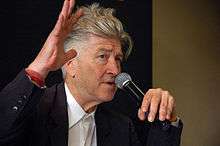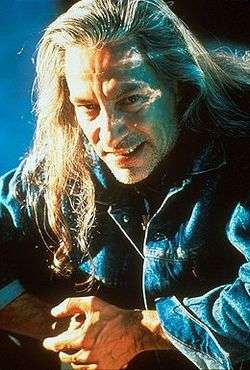Killer Bob
| Killer Bob | |
|---|---|
| Twin Peaks character | |
|
Frank Silva as Bob | |
| First appearance | "Pilot" |
| Last appearance | Fire Walk with Me |
| Portrayed by | Frank Silva |
| Information | |
| Affiliated with | Black and White Lodge |
Killer Bob (or simply Bob) is a fictional character in the ABC television series Twin Peaks.[1] He is a demonic entity who feeds on fear and pleasure. He possesses human beings and then commits acts of rape and murder in order to feast upon his victims.[1]
Bob made his first appearance in the pilot episode, "Northwest Passage", where he makes a brief cameo in a vision had by Sarah Palmer. The character eventually grew into the series' primary antagonist in the second season. Frank Silva, a set dresser on the pilot, was given the role of Bob after a reflection of his face in a mirror was accidentally captured by the camera during filming. When series creator David Lynch saw Silva's face, he liked it so much he kept it in the show, and cast Silva as Bob.[2]
In 2016, Rolling Stone ranked him #5 of their "40 Greatest TV Villains of All Time".[3]
Character arc
Bob is a demonic entity from the Black Lodge, a realm of pure evil which exists on an alternate plane of reality. While possessing humans, he commits horrible crimes to elicit pain, fear, and suffering from those around him.
Dale Cooper first learns of Bob's existence in a vision, in which he encounters another entity named Mike. In this vision, Cooper learns that Bob was in life a serial killer who raped and murdered young women, with Mike as his accomplice. Mike eventually repented, removing his left arm in order to be rid of the tattoo that he shared with Bob.[4] At the beginning of the second season, one of Bob's intended victims, Ronnette Pulaski, awakens from a coma induced by her torture at Bob's hands, at which time she identifies Bob as Laura's killer. Cooper and the Twin Peaks Sheriff department canvass the town with wanted posters of Bob, using Andy's sketch. Leland Palmer, Laura's father, identifies the man in the poster as "Robertson", and says that he lived near his grandfather and used to taunt Leland when he was a child.[5]
When Leland talks about knowing Bob as a child and says this was someone who invited me to play and I invited him in, there's a certain classic type of vampire myth that comes into play when a soul that invites something into it to take part in its life cannot then refuse it anything. That's a myth that goes way back before pre-Christian times and that's one possible explanation... the other is that Leland is just completely whacked out of his mind
—Mark Frost, describing Bob's psychic power, from the book Twin Peaks: Behind-the-scenes: An Unofficial Visitors Guide to Twin Peaks
It is later revealed that Bob is in fact possessing Leland, and has been possessing him ever since Leland first met him as a child at his grandfather's house. Under Bob's influence, Leland molested, raped, and finally murdered his own daughter. Cooper later determines that Bob is possessing Leland, and tricks him into a trap, in which Bob responds with taunting Cooper before forcing Leland to commit suicide.[6] In his dying breaths, Leland states when he was a child he saw Bob in a dream and invited him inside, before stating that he never knew when Bob was in control of his body. After Leland dies, Cooper engages in a philosophical debate with Sheriff Truman and Albert Rosenfield over how real Bob was, and whether or not Bob was in fact a physical incarnation of Leland's personal demons. Although the men cannot agree on a unifying idea, they do come to the conclusion that Bob is a manifestation of "the evil that men do".[7]
Following Leland's death, Bob isn't seen again for a while. In the final episode, Cooper ventures into the Black Lodge to apprehend his former partner, rogue FBI Agent Windom Earle, who is attempting to harness the power of the Lodge for himself. When Earle tries to strike a bargain with Cooper in which Cooper will sell his soul to Earle in exchange for Earle not murdering Cooper's lover, Annie, Bob appears, causing time in the Lodge to reverse to the moment before Cooper agreed to sell his soul. Bob informs Cooper that the Black Lodge is his domain, and thus Earle has trespassed by coming into it and demanding Cooper's soul for himself. As a punishment, Bob kills Earle, taking Earle's soul for himself. Cooper attempts to flee, but Bob traps him in the Lodge, exiting in the form of a doppelganger of Cooper. The series ends with a maniacally laughing Bob examining his new body in a mirror.[8]
Conceptual history

The impetus for the series Twin Peaks was the mystery of who killed Laura Palmer. During the filming of a scene in the pilot, "Northwest Passage", taking place in Laura's room, Frank Silva, a set dresser, accidentally trapped himself in the room by inadvertently moving a dresser in front of the door. When told of the incident, Lynch had an image of Silva stuck in the room and thought it could fit into the series. After filming him crouched at the foot of Laura's bed, looking through the bars of the footboard, as if he were "trapped" behind them, Lynch filmed the scene a second time, without Silva. After reviewing the footage, Lynch liked Silva's presence so much that he decided to make him part of the series.[2]
Later that day, a scene was being filmed in which Laura's mother experiences a terrifying vision; at the time, the script did not indicate what Mrs Palmer had seen. Lynch was pleased with how the scene turned out, but a crew member informed him that it would have to be re-shot, because a mirror in the scene had inadvertently picked up Silva's reflection. Lynch considered this a "happy accident", and decided that Silva's unnamed character would be revealed as Laura's true killer.[2] At the 2013 Twin Peaks Retrospective at USC, Phoebe Augustine (Ronette Pulaski) recalled being afraid of Silva as she noticed him standing out amongst the crew while filming her scene on the railroad tracks in the pilot episode. When Augustine told David Lynch she was becoming afraid of Silva and asked who he was, Lynch, according to Augustine, said, "That's the bad guy but don't tell anyone."[2][9]
References
General references
Altman, Mark A. (1991). Twin Peaks Behind-the-scenes: An Unofficial Visitors Guide to Twin Peaks. Pioneer Books. ISBN 978-1-55698-284-2.
Inline citations
- 1 2 Twin Peaks: The definitive plan to continue the series
- 1 2 3 4 Dunham, Duwayne (2002). "Northwest Passage" audio commentary (DVD). Universal Home Entertainment.
- ↑ Collins, Sean T. (February 9, 2016). "40 Greatest TV Villains of All Time". Rolling Stone. Retrieved April 29, 2016.
- ↑ David Lynch (director); David Lynch and Mark Frost (writers). "Pilot". Twin Peaks. Season 1. Episode 1. American Broadcasting Company.
- ↑ David Lynch (director); David Lynch and Mark Frost (writers). "May the Giant Be With You". Twin Peaks. Season 2. Episode 1. American Broadcasting Company.
- ↑ Lesli Linka Glatter (director); Harley Peyton and Robert Engels (writers). "Demons". Twin Peaks. Season 2. Episode 6. American Broadcasting Company.
- ↑ Tim Hunter (director); Harley Peyton, Robert Engels and Mark Frost (writers). "Arbitrary Law". Twin Peaks. Season 2. Episode 9. American Broadcasting Company.
- ↑ David Lynch (director); Harley Peyton, Robert Engels and Mark Frost (writers). "Beyond Life and Death". Twin Peaks. Season 2. Episode 22. American Broadcasting Company.
- ↑ Stallings, Courtenay (May 7, 2013). "USC Twin Peaks Retrospective: May 5". The Red Room Podcast Blog.
